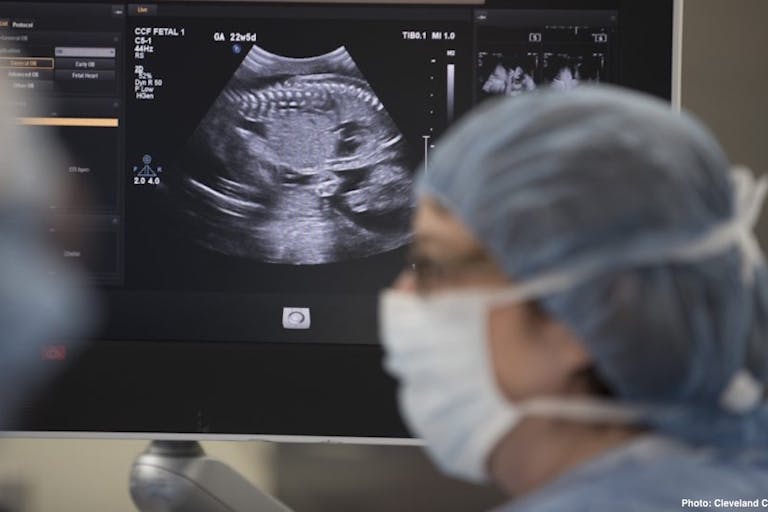
Netherlands sounds alarm over plummeting birth rate, aging population
Cassy Cooke
·
Human Interest·By Nancy Flanders
Mom undergoes in-utero surgery for son with spina bifida to give him ‘the best life’
In-utero surgery for spina bifida, a condition in which the spinal cord is exposed to amniotic fluid through an opening in the baby’s back, is proving to be more beneficial for people with the condition than post-birth surgery. Baby Max is one of the latest preborn babies to undergo the surgery, and the first at Lurie Children’s Hospital in Wisconsin.
The surgery is typically done around 25 weeks in pregnancy and carries risks including premature birth, but Max’s parents Mallorie and Chris knew it was the best chance they had at helping their son, their second child.
“We found out at our 20-week ultrasound that he was diagnosed with spina bifida,” Mallorie told WGN9. “I had heard of it, but I didn’t really know what it was so at that point it was really scary.”
The couple was referred to Dr. Robin Bowman, a fetal neurosurgeon, who told them about the surgery. It was once considered invasive, but now, it can be done with smaller incisions.
“When I initially heard that, I actually thought there’s no way I’m going to have surgery,” Mallory said. “I just thought it was absolutely crazy. And then the more research I did the more I realized this is going to give him the best life.” Her husband, surprised that such a surgery existed, said he was proud of his wife. “I was very impressed with the strength she had to make that decision because it could have negatively affected her in a lot of ways, too,” he explained.
Though nervous about the surgery, the couple trusted that the doctors would do whatever they needed to do to help and protect both mother and child. “I was worried about the health of my baby. I was worried about the health of my wife,” Chris said. “Even though it was hard for us and hard for mom, we wanted to do what was best for him and gave him the best chance of success in life.”
At 25 weeks, Mallorie was put under general anesthesia, and the surgeons inserted two ports for their instruments and a third for a camera.
Article continues below
Dear Reader,
In 2026, Live Action is heading straight where the battle is fiercest: college campuses.
We have a bold initiative to establish 100 Live Action campus chapters within the next year, and your partnership will make it a success!
Your support today will help train and equip young leaders, bring Live Action’s educational content into academic environments, host on-campus events and debates, and empower students to challenge the pro-abortion status quo with truth and compassion.
Invest in pro-life grassroots outreach and cultural formation with your DOUBLED year-end gift!
READ: Cincinnati hospital reaches groundbreaking milestone in prenatal spina bifida surgeries
“The baby is monitored throughout the entire procedure, and the baby is actually very stable,” Bowman explained. “As we free the edges of the spinal cord, it is going to untether the spinal cord so it relaxes back down into the spinal canal. And you want to close it back into a tube, into a spinal cord and then close the coverings to hold that spinal fluid and then close the skin.”
The surgery lasted for seven hours and was a success. Mallorie called it “amazing.”
“You think as a mom you would do anything for your kids,” she said. “And this isn’t something you really ever think you’d have to do, but I’m really happy I could do it for him.”
Mallorie was then scheduled for a C-section at 39 weeks, and was closely monitored throughout the rest of the pregnancy. But on the morning of her scheduled C-section, she went into labor, and baby Max was born within two hours of her arrival at the hospital. Both mother and child are doing well.
“The chance of a really normal life for him really looks apparent,” said Chris. “You can see he’s going to be a thriving, happy young little boy. I don’t think we would have done it any other way.” The surgeons plan to follow Max’s progress and track it compared to the traditional procedures for spina bifida that occur after birth.
Many parents are still advised to abort their babies after a diagnosis of spina bifida. One study found that most abortions due to a fetal diagnosis occur within 72 hours of the parents’ receipt of the test results. A Duke University study found that mothers who abort because of a prenatal diagnosis of “incompatible with life” reported “significantly more despair, avoidance, and depression than woman who continued the pregnancy.” The study also found that there is a “psychological benefit” for women who carry their babies to term.
Progression in medicine is allowing more babies like Max to survive and thrive after a prenatal diagnosis.
“Like” Live Action News on Facebook for more pro-life news and commentary!
Live Action News is pro-life news and commentary from a pro-life perspective.
Contact editor@liveaction.org for questions, corrections, or if you are seeking permission to reprint any Live Action News content.
Guest Articles: To submit a guest article to Live Action News, email editor@liveaction.org with an attached Word document of 800-1000 words. Please also attach any photos relevant to your submission if applicable. If your submission is accepted for publication, you will be notified within three weeks. Guest articles are not compensated (see our Open License Agreement). Thank you for your interest in Live Action News!

Cassy Cooke
·
Human Interest
Angeline Tan
·
Human Interest
Bridget Sielicki
·
Human Interest
Nancy Flanders
·
Human Interest
Nancy Flanders
·
Human Interest
Nancy Flanders
·
Issues
Nancy Flanders
·
Human Interest
Nancy Flanders
·
Investigative
Nancy Flanders
·
Pop Culture
Nancy Flanders
·
Human Interest
Nancy Flanders
·